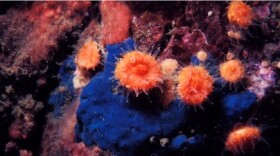A new state initiative called Maritime Blue is pushing for more sustainability in the sector. A 20-member advisory council appointed by Governor Jay Inslee is developing innovation strategies, with the help of consultants from Norway.
That has the head of the Washington State Ferries system dreaming big about how to electrify the fleet.
Speaking at the launch of Maritime Blue, State Ferries Director Amy Scarton presented her vision, which she said was inspired by cajoling from the staff of the new council. She noted that the state Department of Transportation is falling behind on meeting its reduction targets for greenhouse gas emissions. And that if you look at the emissions from all of the vehicles run by WSDOT – all of the heavy equipment, snowplows, cars, trucks and boats – it turns out the ferry system is the biggest culprit.
“Ferry vessels are by far – two thirds of all of the emissions,” she said.
Her power point showed the 22 ferries in the state system belching out a whopping 67% of the transportation department’s air pollution. That’s because they run on huge diesel engines. Scarton calculated they collectively burn an average of about 1,000 gallons of diesel every hour.
She said she wants to green the fleet by switching to electric power wherever possible. And she has honed in on the first target: converting the engines aboard the three Jumbo Mark 2 ferries that serve on the Seattle-Bainbridge and Edmonds-Kingston runs.
“They are the largest vessels and of the 22 active vessels in our fleet, just these three account for 26 percent of all of our diesel use,” Scarton said.
If her vision becomes reality, the Tacoma, the Wenatchee and the Puyallup will start using hybrid electric engines in less than a decade. A lot would have to happen to make that a reality – for example, getting power lines and chargers ready not just at larger docks such as Seattle, but in more out-of-the-way places, like on Bainbridge Island and Kingston. Scarton says start-up costs would be offset by savings on fuel and maintenance. She says this is not just a pie in the sky idea.
“The international ferry market has shown us that it’s possible. There are projects all over the world now. This technology is off the shelf. So it’s a distinct possibility, but again, it’s about working with the stakeholders here in the state to figure out is this the way to move forward for Washington state,” Scarton said.
She says the Jumbo Mark 2s are due for upgrades anyway and could last another 40 years. There’s also a possibility that money from the settlement with VW over its cheating on emissions tests could be used to transition the ferry system to electric power.
Thanks to Maritime Blue, the transition would have policy and technical support from a panel of experts. Norway is among the countries that have already converted to electric ferries and the consultants supporting the initiative bring that experience to the table. The new innovation council is also setting up an Innovation Center at the Port of Seattle, to incubate new technologies in cooperation with the University of Washington’s Applied Physics Lab.
The year-long program is made possible by a $500-thousand dollar grant from the US Department of Commerce that’s matched with state and local funds.







